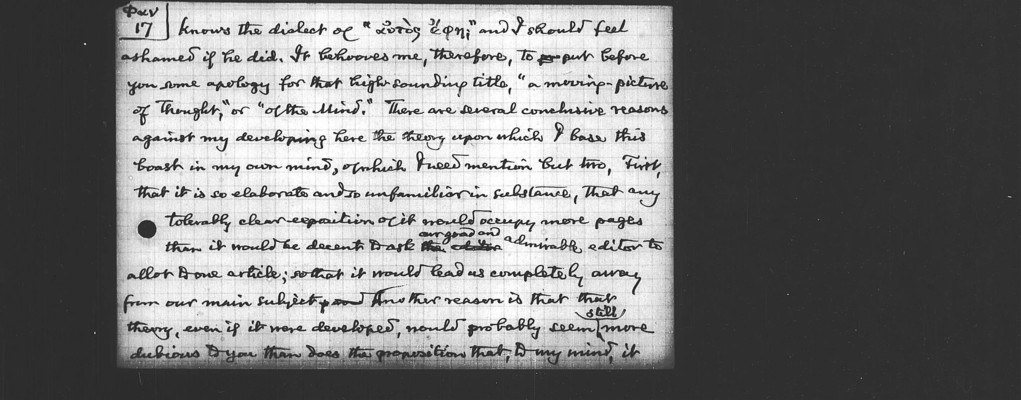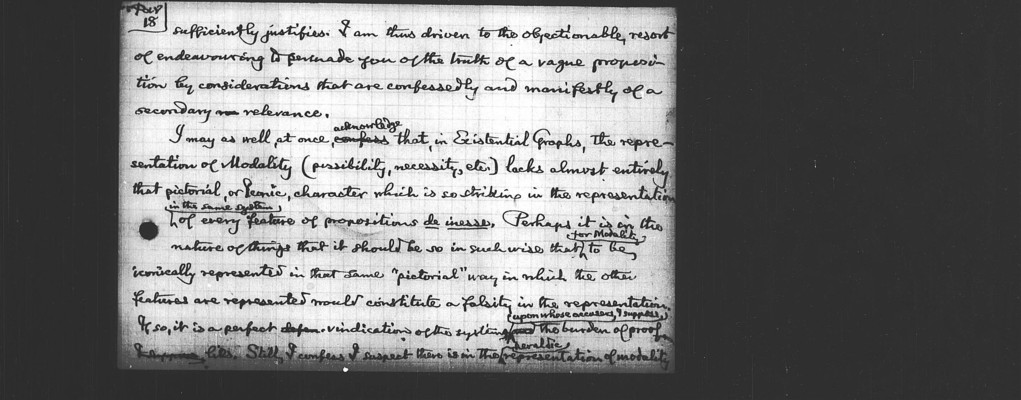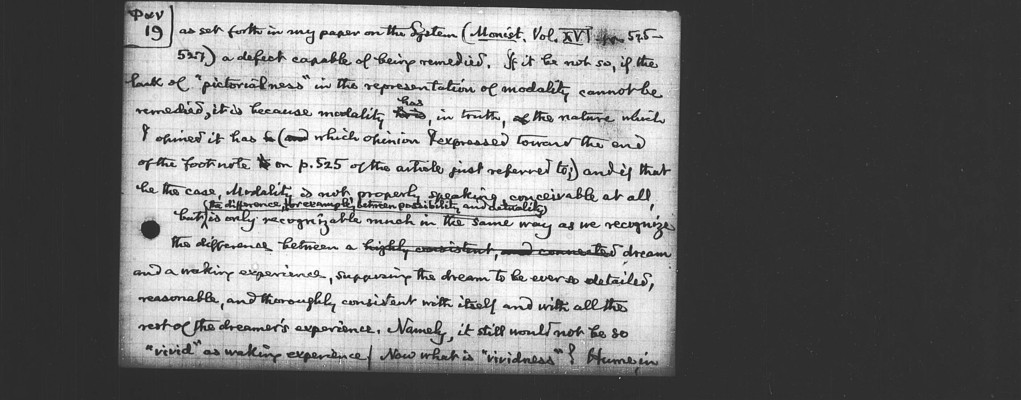Pages
21
φαν16
“Thought.”
I trust by this time, Reader, that you are conscious of having some idea, which perhaps is not so dim as it seems to you to be, of what I mean by calling Existential Graphs a moving-picture of Thought. Please note that I have not called it a perfect picture. I am aware that it is not so: indeed, that is quite obvious. But I hold that it is considerably more nearly perfect than it seems to be at first glance, and quite sufficiently so to be called a portraiture of Thought. Yet very likely you may be indisposed to admit this except in some very gross sense. Certainly, no true scholar of mine in any science, least of all in logic, for all my having sometimes playfully called my fundamental principle “Ceno-pythagoreanism” (“ceno” = καινός, new), at all
22
φαν17
knows the dialect of “αὐτός ἔφη”; and I should feel ashamed if he did. It behooves me, therefore, to put before you some apology for that high-sounding title, “a moving-picture of Thought,” or “of the Mind.” There are several conclusive reasons against my developing here the theory upon which I base this boast in my own mind, of which I need mention but two, First, that it is so elaborate and so unfamiliar in substance, that any tolerably clear exposition of it would occupy more pages than it would be decent to ask our good and admirable editor to allow to one article; so that it would lead us completely away from our main subject. Another reason is that that theory, even if it were developed, would probably seem still more dubious to you than does the proposition that, to my mind, it
23
φαν18
sufficiently justifies. I am thus driven to the objectionable resort of endeavouring to persuade you of the truth of a vague proposition by considerations that are confessedly and manifestly of a secondary relevance.
I may as well, at once, acknowledge that, in Existential Graphs, the representation of Modality (possibility, necessity, etc.) lacks almost entirely that pictorial, or Iconic, character which is so striking in the representation in the same system of every feature of propositions de inesse. Perhaps it is in the nature of things that it should be so in such wise that for Modality to be iconically represented in that same “pictorial” way in which the other features are represented would constitute a falsity in the representation. If so, it is a perfect vindication of the system, upon whose accusers, I suppose, the burden of proof lies. Still, I confess I suspect there is in the heraldic representation of modality
24
φαν19
as set forth in my paper on the System (Monist, Vol. XVI, pp. 525– 527) a defect capable of being remedied. If it be not so, if the lack of “pictorialness” in the representation of modality cannot be remedied, it is because modality has, in truth, the nature which I opined it has (which opinion I expressed toward the end of the footnote on p. 525 of the article just referred to;) and if that be the case, Modality is not, properly speaking, conceivable at all, but the difference, for example, between possibility and actuality is only recognizable much in the same way as we recognize the difference between a dream and a waking experience, supposing the dream to be ever so detailed, reasonable, and thoroughly consistent with itself and with all the rest of the dreamer's experience. Namely, it still would not be so “vivid” as waking experience. Now what is “vividness”? Hume in
25
φαν20
the “Treatise,” confounds it with the intenseness of the feeling. They certainly cannot be the same since, although memory is notoriously dimmer, i.e. less vivid, than perception, we do not remember a gamboge yellow as olive-color, nor a somewhat warmer yellow as brown. A slight experimental investigation, which I made in 18.., afterward supplemented in various ways, has led me to the following conclusions:
1. A slight psychological connexion only exists between vividness with its opposite, faintness, and intenseness of feeling with its opposite, dullness; in that when a genuinely warm interest and attention had greatly increased the vividness of the sensation of a particular object, according to the direct introspective testimony of consciousness, measurement showed a very slight increase of its intenseness, an increase




